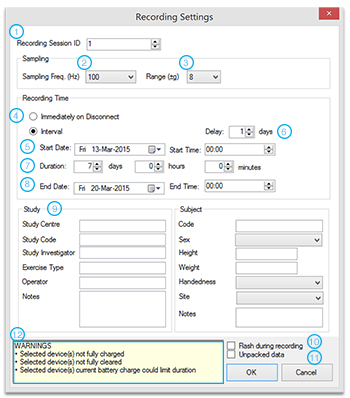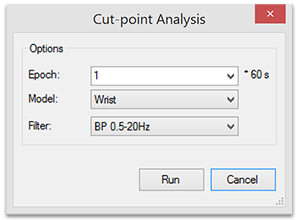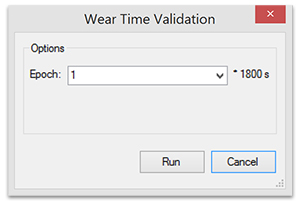Software Features
Interface orientation

- Device Toolbar
- Device Browser Pane
- Data Preview Window
- Selection Tools
- Preview Filters
- Working Folder
- Working Folder Options
- Local File Browser Pane
- Data Files Tab
- Plugin Tab
- Output Tab
- Analysis Toolbar
- Plugins Button
For devices that have data stored on them, the Data Preview Window gives an overview of the recording and the Preview Filters on the right may be used to toggle data streams on or off.
The OMGUI software was programmed with the following functions in mind:
- Configuring sensors for recording
- Previewing and downloading data
- Analysis and data manipulation
The above topics will now be discussed in detail.
Configuring sensors for recording
The OMGUI software displays all connected devices and their states in the Device Browser Pane. This information can be used for checking a devices current configuration as well as making sure the battery level is sufficient to complete the recording required.
NOTE: Best practice not to issue a device with less than 85% battery level.
With a device in the Device Browser Pane selected, the buttons on the Device Toolbar can be used to perform the following operations:
-
Download. If the connected device has any data recordings, this button downloads the recordings to the Working Folder.
-
Cancel. If the connected device is being downloaded, this button terminates the operation.
-
Clear. If the connected device has and data recordings, this button clears them. This operation is irreversible.
-
Stop. If the device is currently set to record, this button will clear the configuration so that when the device is disconnected it will enter into Standby mode.
-
Identify. This button will flash the LED on any selected device. It is designed to assist device identification when multiple devices are connected at once.
-
Record. This button is used to configure the device to record. The button brings up the Recording Window:

-
Recording Session ID. This field provides utility to mark the recording with a unique ID. This is useful in studies where patient data needs to be anonymized as the ID can be linked to a patient record.
-
Sampling Frequency. This is the number of times per second the sensor data will be recorded. For more information on choosing a sample frequency please see the sensor user manual. The default value is 100Hz which is adequate for most human movement studies.
-
Sampling Range. This is the maximum value that the sensor will record. For more information on choosing a range please see the sensor manual. The default setting is suitable for most human movement studies.
-
Immediately on Disconnect. In this configuration the sensor will start recording as soon as it is unplugged from the computer.
-
Interval Start Date/Time. If the interval option is selected, the user can select a specific date and time to start recording on.
-
Interval Delay. In interval mode, the user can specify a number of days before the sensor will start recording with the present day as an index. For example “start recording in 2 days time”. The user is also able to directly select a date, and fine tune the start time using the Start Date/Time options.
-
Interval Duration. In interval mode, the user can specify a duration to record for. If the duration exceeds the physical capabilities of the device, a warning will be given.
-
Interval Stop Date/Time. In interval mode, the user can specify a specific date and time to stop recording on. If the duration exceeds the physical capabilities of the device, a warning will be given.
-
Study and Subject Meta Data. The device is able to store meta data along with the recorded data. This section provides the user provision to add a series of descriptive fields that will persist alongside the data recording; thus alleviating the possibility of metadata misalignment at a later date. All fields are optional in this section.
-
Flash during recording. If checked, this box will put the device in a mode whereby a small flash is periodically given when a device is actually recording (if an interval is set, the device will remain silent during the standby phase). Default is to have the device silently record to avoid wearer disruption.
-
Unpacked data. If checked, this option will configure the device to adopt a 6-bytes per sample format. Left unchecked (default) the device will adopt a 4 bytes per sample "packed" format, which enables it achieve a logging performance of 14 days at 100Hz with sufficient resolution for human movement studies.
-
Notes Area. This section is used for warnings to the user about any potential issues with the chosen configuration.
Previewing and downloading data
Any connected devices will appear in the Device Browser Pane marked as having data. When highlighted, data on these devices can be previewed in the Data Preview Window. There is a Zoom tool and Highlight tool in the Selection Tools section. In the Preview Filters section, a number of checkboxes exist to help the user visualize the data. On mousing over the data, the user is able to get a precise data preview at any given instant in the recording.
Recorded data stored on the sensor can be downloaded to the Working Folder by clicking the Download button. Download time is approximately 6 minutes for 7 days worth of data.
To open and view the contents of the Working Folder or change working folders, buttons are available in the Working Folder Options part of the interface.
Analysis and data manipulation
Downloaded data will appear in the Data Files Browser Pane. This section of the interface displays all data files currently stored in the Working Folder. When a file is highlighted, a preview of the data is shown in the Data Preview Window. The OMGUI provides several ways for working with data:
- Export Function for working with data in an external analysis package
- Integrated algorithms (via Analysis Toolbar) for working with data via pre-validated algorithms
- Plugins for working with data via an externally developed analysis package within the OMGUI environment
Export Function
Captured recordings are stored in a binary format that is not always directly compatible with external program environments. For this reason a built-in export facility is provided to enable captured recordings to be transcribed into various formats.
Export Re-sampled WAV
This option can be used to transcribe the binary format file into an audio WAVE file (WAV). In this format the data streams are interpolated over the recording duration. This is done via a bi-cubic spline algorithm. The WAV converter re-samples the binary data file produced on-board the accelerometer to produces a 4-channel, 16-bit standard WAVE file. The first three channels correspond to the X-, Y- and Z-axes from the accelerometer (and a normalized -1 to 1 value must be scaled by the range setting, which can be obtained from the WAV header, with a default of 8 for +/- 8g). The fourth channel contains other information from the logging device, such as temperature, light and battery measurements -- encoded into the 16-bit values.
Export Re-sampled CSV
This operation can be used to convert a binary file into a CSV file format with a fixed sample period; useful for analysis that cannot handle variable sample rates. A bi-cubic interpolation is used to determine timestamps.
NOTE: CSV files of samples are considerably larger than binary counterparts and thus consideration to memory requirements must be given when using them. Binary WAV files should be preferred where it is possible to use them.
Export Raw CSV
The Export Raw function allows a destination to be chosen, and has a separate window where a variety of export options can be chosen:

The following options are available on the Export Raw Window
-
Output File Path. This is the location where the output file will be placed. The user must have write permission to this location.
-
Accelerometer Units. The exporter provides utility to provide either the accelerometer readings as raw sensor values, or in units of 'g' (1g = 9.81 m/s2).
-
Sub-Sample. Using the Selector Tool in the Data Preview Window, a specified data slice can be passed to the export window. The start and end of this slice can be verified in this section of the window.
-
No Timestamp Information. Column 1, 2 and 3 of the CSV file will be X, Y, Z accelerometer axis respectively.
-
Sample Number will generate an incrementing number in column 1. Column 2, 3 and 4 will be X, Y, Z accelerometer axis respectively.
-
Formatted will generate a timestamps formatted in ISO 8061 format (
YYYY-MM-DD hh:mm:ss.fff) in column 1. Column 2, 3 and 4 will be X, Y, Z accelerometer axis respectively. -
Seconds (relative to start) will generate timestamps in seconds relative to the first sample in Column 1. Column 2, 3 and 4 will be X, Y, Z accelerometer axis respectively.
-
Seconds (Unix epoch) will generate time in Unix format (POSIX time); seconds since epoch of 1st January 1970. Column 2, 3 and 4 will be X, Y, Z accelerometer axis respectively.
-
Fractional Days (relative to start) will generate time in fractions of days relative to the first sample. Column 2, 3 and 4 will be X, Y, Z accelerometer axis respectively.
-
Fractional Days (Excel) will generate time in fractions of days since the Microsoft Excel epoch (1st Jan 1900). Column 2, 3 and 4 will be X, Y, Z accelerometer axis respectively.
-
Fractional Days (Matlab) will generate time in fractions of days since the Unix epoch (1st Jan 1970). This is the time format Matlab and R use. Column 2, 3 and 4 will be X, Y, Z accelerometer axis respectively.
Analysis Toolbar
The Analysis Toolbar provides the user fast provision to work with a selection of validated algorithms within the OMGUI environment.
Signal Vector Magnitude (SVM)
The signal vector magnitude (SVM) has been shown to be a useful measure for working with when axis specific information is not required. The SVM can be calculated in conjunction with, or without, a bandpass filter. Options for using the SVM calculation are now explained:

-
Epoch. This is the length of time each SVM averaging is made over. Default is 60 seconds. If number of samples in the file does not fit into an exact integer of epochs, the last epoch will be partial.
-
Mode. The SVM calculation can be made in a mode where all negative values of the SVM are rectified: abs(sqrt(x^2 + y^2 + z ^2)-1), or discarded: max(0,sqrt(x^2 + y^2 + z ^2)-1)
The output of the SVM tool is a CSV file stored in the working folder.
In detail: the signal vector magnitude takes the accelerometer vector length from the euclidean distance of the three accelerometer axes, and subtracts the 1g expected from gravity while stationary:
SVM-1 = sqrt(x^2 + y^2 + z^2) - 1
This signal can (optionally) be improved by filtering for only frequencies of human movement, by applying a fourth-order Butterworth band-pass filter between 0.5Hz and 20Hz. Negative values are dealt with by either taking the 'absolute' value (default), or clipping them to zero. This value is aggregated into a mean measurement over user-defined epoch length (in seconds). The resulting means are then, either:
sum(abs(sqrt(x^2 + y^2 + z^2) - 1))
sum(max(0, sqrt(x^2 + y^2 + z^2) - 1))
For more details on the SVM algorithm and the selection of apporpriate cut-points see 1.
Cut-points
When using the accelerometers to measure physical activity, time spent in specific states has been demonstrated to be a useful output. The Cut-point analysis reports the time user has spent in a specific intensity of physical activity where each intensity band is categorized in units of Metabolic Equivalent of Task (METS).
| Activity Level | MET Threshold |
|---|---|
| Sedentry | < 1.5 |
| Light | 1.5 < and < 3.99 |
| Moderate | 4.0 < and < 6.99 |
| Vigorous | 7.0 < |
1 MET = 3.5 ml O2 . kg^-1 . min ^-1 which is the equivalent of 58.2 W/m^2 or the rate of energy produced per unit surface area of an average person seated at rest.
To provide utility of converting accelerometry data into METS for specific population groups and for specific mounting sites of the sensor, the following interface is provided:

This algorithm is based on that proposed in 2, which takes an abs(SVM-1) values at 80Hz summed over 60 seconds. Our implementation compares the mean SVM over 60 seconds against 'cut points' which divide the results into time spent in activity levels: sedentary (< 1.5 METS), light (>= 1.5 METS, < 4 METS), moderate (>= 4 METS, < 7 METS), and vigorous (>=7 METS). The results are summed over user-defined multiples of the 1-minute epoch.
Wear Time Validation (WTV)
The wear time validation (WTV) algorithm is designed to give a high level view if the device has been worn or not. It is unspecific to mounting site and based on the accelerometer readings. A screen-shot of the interface is give below.

The algorithm is based on the method proposed in 2, where accelerometer non-wear time is estimated from the standard deviation and range of each accelerometer axis calculated over 30-minute periods. Each period is classified as non-wear time if the standard deviation was less than 3.0 mg for at least two out of the three axes, or if the value range, for at least two out of three axes, was less than 50 mg. The results are summed for user-defined multiples of 30 minute intervals.
The units reported in the WTV are the sum of the number of 30min windows detected within the epoch period. For example, if the epoch period is 1 hour and the sensor is worn continuously, the result will be 2. If the sensor is worn for the first 30 mins and then removed, the result will be 1. In the WTV process, windows are non-overlapping and treated as discrete chunks.
Sleep Analysis
The sleep analysis is based on the method proposed and validated by Borazio et al in 4. The basis behind the algorithm is to summarize the raw signal into epoch periods. For each epoch period the standard deviation is calculated and this parameter is then exposed to a threshold. Bouts where the signal is of low energy are classified as sleep; the output is binary awake|asleep per epoch.
In the present version, the parameters suggested and validated by Borazio et al have been emulated exactly with no method for user experimentation. They are optimised for smaple rate Fs = 100Hz and will work at any ±4,8,16g ranges. For data collected at FS ~= 100Hz, the method used to summarize the data into epoch periods is sympathetic to sample rate.
Plug-ins for OMGUI
Plug-ins provide a way for developers to develop their own algorithms in their choice of environment and link them into the OMGUI interface. If you are interested in developing plug-ins or for more please consult the Open Movement source code pages at www.openmovement.co.uk.